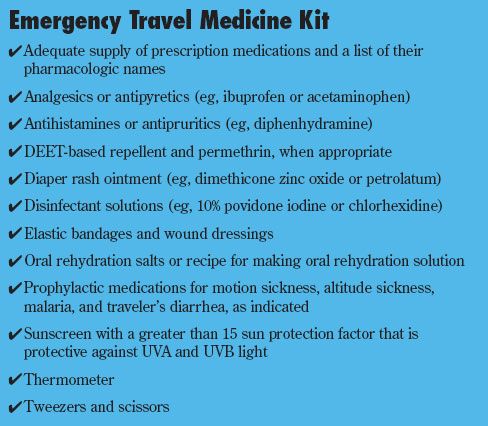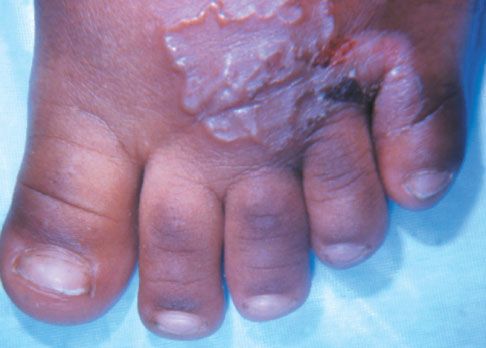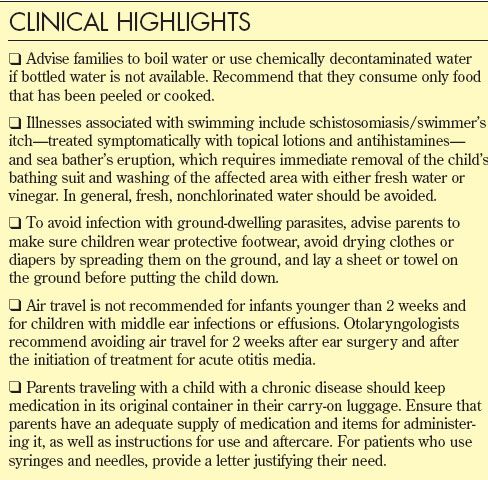- Clinical Technology
- Adult Immunization
- Hepatology
- Pediatric Immunization
- Screening
- Psychiatry
- Allergy
- Women's Health
- Cardiology
- Pediatrics
- Dermatology
- Endocrinology
- Pain Management
- Gastroenterology
- Infectious Disease
- Obesity Medicine
- Rheumatology
- Nephrology
- Neurology
- Pulmonology
Travel Risks: How to Help Parents Protect Infants and Young Children
Children are at greater risk than adults for many travel-related problems, such as barotitis and barotrauma associated with flying, cold and heat injury, drowning, and infection with geohelminths. Most of these problems can be avoided with appropriate measures. Here, a summary of the most important steps.
Although infants and children make up only 4% of all international travelers, they account for 25% of travel- related hospitalizations.1,2 With appropriate preparation, however, travel can be safer and more enjoyable for the entire family. You have an important role in helping families prevent travel-related illnesses and injury.
Here we provide practical tips you can offer parents who plan to travel with infants and children. The key advice to give these families can be summed up as "precaution and prevention."
PRETRAVEL COUNSELING
Travel insurance coverage. Accidents are the leading cause of mortality in young travelers.3 Advise parents to check the coverage provided by their regular health plans for international travel. If their health plans lack this coverage, parents should purchase travel and evacuation insurance, since the cost of evacuation can range from $25,000 to $100,000 per person.
Child identification. Long travel times, layovers between flights, and unfamiliarity with new areas can result in the separation of children from their parents. Therefore, children must have identification on them at all times during travel.
International travel with one parent. The accompanying parent must have a notarized letter of permission from the nonaccompanying parent. If the accompanying parent has custody or is a widow/widower, a notarized copy of the custodial document or death certificate may also be required. Immigration and Naturalization Services, as well as the State Department, have been known to request such notarized documents before they will allow a child to travel with only one parent internationally.4
PREPARING THE CHILD
Anxiety about travel to unfamiliar areas is very common among children. Here are some ways to reduce this stress:
•Inclusion in the planning process. Parents can prepare their children for travel with videos, books, pictures, foods, and Internet resources. Planning for the areas they will visit, people they will meet, and foods they will eat during their journey gives children a sense of control and ownership of the travel process.
•Items of security or familiarity. It may be helpful for the child to bring a special toy, blanket, or picture to establish a sense of security and familiarity.
•Anticipation of disrupted routines. Parents should explain to children that problems associated with travel--such as long delays, irregular meals, and alterations in schedules and nap times--may disrupt their normal routines. Parents also should be prepared for unexpected frustrations and for entertaining children during long periods in confined spaces.
AIR TRAVEL
Contraindications. Air travel is not recommended for infants younger than 2 weeks because of the possibility of surfactant deficiency, with its associated risks of perfusion-ventilation mismatch, alveolar collapse, and pneumothorax.5,6 The CDC does not recommend air travelfor infants younger than 6 weeks.7
Otolaryngologists generally recommend that air travel be avoided for 2 weeks after ear surgery (eg, after tympanomastoidectomy, stapedectomy, labyrinthectomy, or acoustic neurectomy), since blockage of the eustachian tubes is known to cause pain and can lead to perforation of the tympanic membrane during air travel. Similarly, middle ear infections and effusions also are contraindications to air travel.5
Barotitis and barotrauma--resulting from compression of the eustachian tubes--cause ear pain in 15% of children during descent.8 The eustachian tubes can be decompressed by swallowing motions. These can be induced by breast-feeding or bottle-feeding infants and by having older children chew gum, blow up a balloon, or plug their nose and blow.
Because barotitis can also be caused by acute otitis media (AOM) with effusion,5 it is recommended that children with AOM wait 2 weeks after treatment is initiated before flying.9 In contrast, complete effusions and pneumonostomy tubes are not contraindications to flying, since they protect against middle ear barotraumas by minimizing pressure changes. Although pseudoephedrine has been used to prevent barotraumas in adults, its effectiveness has not been proved in children.10
Restraining devices. Althoughthe Federal Aviation Administration (FAA) recommends that children younger than 2 years be restrained during air travel, it prohibits the use of lap belts (belly belts), booster seats, and vests for this age group.11 However, FAA-approved car seats are permitted if the parent purchases a ticket for a child younger than 2 years and if the car seat carries an original intact FAA-approval manufacturer's sticker. Some international airlines provide special child-restraining devices that anchor the child to the parent's seat belt.

Jet lag. Because of their adherence to natural circadian rhythms, children and infants are less prone to jet lag.12 The following advice can be offered to parents in the event of jet lag or difficulties in adjusting to new sleeping routines.
Adjustment of sleeping and eating patterns during and immediately after air travel can help ameliorate jet lag. Exposure to the sun or other bright light in the morning for eastward travel, and in the afternoon for westward travel, also helps combat jet lag.12
Use antianxiety agents, such as benzodiazepines, with extreme caution in children, because of the lack of clinical experience as well as the potentially devastating effects of accidental overdose. Experience with melatonin in children is extremely limited, and there are no controlled studies of the use of melatonin in this population. In addition, melatonin may affect sexual maturation.13 Therefore, this agent should not be prescribed for children.
Motion sickness. In children, motion sickness is usually accompanied by nausea, vertigo, pallor, and cold sweats.14 Ataxia, in children younger than 5 years, and nausea, in children older than 12 years, are the most frequent symptoms. The most common medications used to control motion sickness in children are diphenhydramine and dimenhydrinate.14
Several medications used to control motion sickness in adults should be avoided in children. Antidopaminergics, such as metoclopramide and prochlorperazine, are not recommended, because of their ineffectiveness in controlling motion sickness and their association with extrapyramidal symptoms in children. Scopolamine also is not recommended, because of its known side effects and lack of clinical experience in children.
WATER AND FOOD SAFETY
Diseases acquired from contaminated food and water can be prevented by commonsense approaches to food handling, preparation, and consumption, and by proper hygiene (eg, use of clean water for brushing teeth).
The most reliable source of clean water is bottled water. If bottled water is not available, parents should boil water or use water that has been chemically treated for decontamination. Water filtration does not effectively eliminate viruses, particularly rotaviruses and hepatitis A virus.15 However, combination chemical and filtration devices are effective and can be safely used to purify water.
Stress the importance of washing hands with soap and clean water before touching, preparing, or eating food. For the consumption of any food, advise parents to "peel it, cook it, or forget it." In general, food sold by street vendors should not be given to children.7 Encourage parents to carry finger foods or snacks during travel because of the irregularity of meal times. Recommend that mothers continue breast-feeding. For mothers whose infants are formula-fed, emphasize the importance of an adequate supply of formula and clean water.
ENVIRONMENTAL RISKS
Infants and children are more susceptible than adults to environmental risks.
Transportation. A car seat is a must for children younger than 4 years. If a car seat is not available at the destination, it should be carried by the family. Recommend that families rent larger, heavier cars with appropriate seat belts, rather than smaller cars.
Physical surroundings. Children should be closely supervised in heavy traffic areas. Many countries do not have public health and building codes comparable to those in the United States. Therefore, advise parents to check hotel rooms for potential hazards, such as open electrical wiring and sockets, paint chips, pest poisons or traps, and low or unstable balcony railings.16
Sun exposure. In most persons, more than 80% of sun exposure occurs before the age of 21, and the risk of melanoma doubles in those who had 1 or more severe sunburns in childhood.17 Avoiding exposure to the sun has been shown to reduce the risk of skin cancer significantly.18 Infants and children should be kept out of direct sunlight and should wear protective clothing (hats and long-sleeved, loose-fitting shirts) to decrease exposure to sun. In addition, strongly encourage the application of waterproof sunscreen with a sun protection factor of 15 or higher.
Insect avoidance. Since several infections can be transmitted via insect bites, stress the avoidance of insects to travelers. Also, note that antimalarials do not provide protection against most insect-borne diseases. Families who travel to at-risk areas should wear light-colored, protective clothing (long-sleeved shirts, long trousers, socks)and sleep in protective environments (screened quarters and mosquito netting).
Insect repellents with DEET (N,N-diethyl-3-methylbenzamide), at a concentration of 30% to 35%, are safe and effective in infants and children19; higher concentrations of DEET may be toxic in children.20 DEET is now available in slow-release formulas, which substantially increase duration of protection while decreasing exposure.
Permethrin applied to children's clothing lasts several weeks, even with washing, and is effective against mosquitoes and ticks. A practical and effective measure is to use permethrin in combination with a DEET product: permethrin can be applied to the clothing even before travel, and slow-release DEET lotion can be applied to the skin every 24 hours.
Heat and cold injuries. Infants and children are unable to anticipate and avoid heat and cold stress and are therefore more prone to injury caused by temperature extremes. Such injury occurs for several physiologic reasons:
•Increased surface areato-mass ratio.
•Greater metabolic heat unit mass with exercise.
•Decreased cardiovascular capacity to convey heat from the core to the periphery.
•Decreased capacity for evaporation cooling.
•Less ability to acclimatize to heat.
•Inefficient thermoregulation.21
Heat injuries can be prevented by maintaining hydration, wearing loose and light-colored clothing, limiting physically demanding midday activities, and avoiding exposure to direct sun. Water is sufficient to treat mild dehydration. Electrolyte replacement is necessary only in extreme circumstances.
Injuries caused by cold can be prevented by wearing tight-fitting, dark-colored clothing that covers most of the body. Clothes should be layered: an underwear layer that wicks away moisture (such as polyesters), an insulating layer (such as wool or fleece), and an outside shell (such as nylon).22
Altitude. At high altitudes, infants and children may experience acute mountain sickness (AMS), characterized by unexplained fussiness, with alterations in appetite, activity, or sleep patterns during or after recent exposure to altitude.23 AMS is usually benign, but it may progress to high-altitude cerebral edema or high-altitude pulmonary edema if not treated promptly. Acetozolamide, at a recommended dosage of 5 mg/kg/d divided bid or tid, is an effective prophylactic in adults and children24; however, this agent is contraindicated in children who are allergic to sulfa.
Animal exposures. The highest incidence of rabies worldwide is in children25; thus, it is important to keep children away from animals during travel. Recommend vaccination to families who are planning to stay in an area of risk for more than 30 days.7 If a child is bitten or scratched by an animal, the wound should be scrubbed immediately with copious amounts of water and soap. Stress the need to consult the local medical facility as soon as possible after exposure to an animal.
Dangers of water activities. Drowning is the second leading cause of death among children.26 Children should be well supervised around water, and parents should closely monitor tides, currents, and warnings. If the vacation involves numerous water activities, parents should carry approved safety devices, which may not be available in the appropriate size at the destination.
Illnesses associated with swimming include schistosomiasis/swimmer's itch--treated symptomatically with topical lotions and antihistamines--and sea bather's eruption, which requires immediate removal of the child's bathing suit and washing of the affected area with either fresh water or vinegar. In general, fresh, nonchlorinated water should be avoided. If contact with potentially contaminated water occurs, the child should be vigorously dried with a towel to prevent cercarial skin penetration.27 Recommend the use of protective footwear in aquatic areas.
Parasitic infestations. Warn travelers to tropical Africa or South America about myiasis (infestation by botfly or tumbu fly larva).28 Cutaneous infections can be prevented by ironing clothes before wearing them. Advise parents to avoid drying clothes or diapers by spreading them on the ground.6
Tungiasis, cutaneous larva migrans, and infections with geohelminths (ground-dwelling parasites) are rare (Figure). However, because children are in greater contact with the ground, they are more likely to become infected with organisms found in soil (Ascaris,Trichuris, hookworm, Strongyloides, Tunga penetrans) and sand (hookworm larvae).29 Parents should put protective footwear on their child and lay a sheet or towel on the ground before putting the child or infant down.6

CHRONIC DISEASES AND TRAVEL
Advise parents to consult a travel medicine specialist if their child has a preexisting medical condition.
Instruct parents to keep medication in its original container in their carry-on luggage. Examples of medications to carry on the plane include:
•Oral corticosteroid burst or topical corticosteroid for children with eczema or asthma.
•Insulin and an adequate supply of syringes and needles, with a letter justifying their need, for children with type 1 diabetes mellitus.
•Preloaded epinephrine syringe along with instructions on use and aftercare for children with a history of allergic and anaphylactic reactions to bee stings, shellfish, or peanuts. Epinephrine syringes are available for children who weigh less than 30 kg (67 lb).
Manage more complicated conditions (cystic fibrosis, HIV/AIDS, congenital heart disease, and renal disease) in children in consultation with their respective specialists.
Advise parents to pack a medicine kit that contains prescription medications and other first aid supplies (Box). Tell them to seek medical attention early at the first signs and symptoms of disease, such as high fever, lethargy, unexplained fussiness, crying without tears, dry mouth, high respiratory rate, increased work of breathing, or toxic appearance.
Consider providing parents with a list of resources on traveling with infants and children. Online resources are available from the CDC (wwwn. cdc.gov/travel) and the Global Infectious Disease and Epidemiology Network (www.GIDEONonline.com). *

References:
REFERENCES:1. Riordan FA, Tarlow MJ. Imported infections in east Birmingham children. Postgrad Med J. 1998;74:36-37.
2. Klein JL, Millman GC. Prospective, hospital based study of fever in children in the United Kingdom who recently spent time in the tropics. BMJ. 1998;316:1425-1426.
3. Hargarten SW, Baker TD, Guptill K. Overseas fatalities of United States citizen travelers. An analysis of deaths related to international travel. Ann Emerg Med. 1991;20:622-626.
4. Rose SR. International Travel Health Guide. 15th ed. Northampton, Mass: Travel Medicine Inc; 2004.
5. Medical guidelines for air travel. Aerospace Medical Association, Air Transport Medicine Committee, Alexandria, Va. Aviat Space Environ Med. 1996; 67(10 suppl):B1-B16.
6. Barry M. Medical considerations for international travel with infants and older children. Infect Dis Clin North Am. 1992;6:389-404.
7. Department of Health and Human Services, Centers for Disease Control and Prevention. Health Information for International Travel 2005-2006. St Louis: Mosby-Year Book Inc; 2005.
8. Armstrong HG, Heim JW. Effect of flight on the middle ear. N Engl J Med. 1937;109:417-421.
9. Fisher PR. Children, earache and travel. Travel Medicine Update. 1995;5:531-532.
10. Buchanan BJ, Hoagland J, Fischer PR. Pseudoephedrine and air travel-associated ear pain in children. Arch Pediatr Adolesc Med. 1999;153:466-468.
11. Code of Federal Regulations. Federal Aviation Regulations. Part 121: Operating requirements: domestic, flag, and supplemental operations. Sec. 121.311--Seats, safety belts, and shoulder harnesses.
12. Waterhouse J, Reilly T, Atkinson G. Jet-lag. Lancet. 1997;350:1611-1616.
13. Cavallo A, Ritschel WA. Pharmacokinetics of melatonin in human sexual maturation. J Clin Endocrinol Metab. 1996;81:1882-1886.
14. William S, Robert K, Gregory P, et al. "Stop the car, Mom, I'm going to be sick!" Contemp Pediatr. 2002;7:43.
15. Backer HD. Field water disinfection. In: Auerbach PS, Geehr ED, eds. Wilderness Medicine: Management of Wilderness and Environmental Emergencies. St Louis: CV Mosby Co; 1989:805-827.
16. Foster JA, Watson B, Bell LM. Travel with infants and children. Emerg Med Clin North Am. 1997; 15:71-92.
17. Graham S, Marshall J, Haughey B, et al. An inquiry into the epidemiology of melanoma. Am J Epidemiol. 1985;122:606-619.
18. Ferrini RL, Perlman M, Hill L. American College of Preventive Medicine practice policy statement: skin protection from ultraviolet light exposure. Am J Prev Med. 1998;14:83-86.
19. Gentile DA, Kennedy BC. Wilderness medicine for children. Pediatrics. 1991;88:967-981.
20. Roland EH, Jan JE, Rigg JM. Toxic encephalopathy in a child after brief exposure to insect repellents. Can Med Assoc J. 1985;132:155-156.
21. American Academy of Pediatrics Committee on Sports Medicine. Climatic heat stress and the exer-cising child. Pediatrics. 1982;69:808-809.
22. Hamlet M. The science of clothing for the outdoors. Wilderness Medicine Letter. 2000;17:1-14.
23. Yaron M, Waldman N, Niermeyer S, et al. The diagnosis of acute mountain sickness in preverbal children. Arch Pediatr Adolesc Med. 1998;152:683-687.
24. Carpenter TC, Niermeyer S, Durmowicz AG. Altitude-related illness in children. Curr Probl Pediatr. 1998;28:177-198.
25. Rotivel Y, Goudal M, Wirth S, Tsiang H. Rabies is a risk for traveling children [in French]. Arch Pediatr. 1998;5:561-567.
26. Sniezek JE, Smith SM. Injury mortality among non-US residents in the United States 1979-1984. Int J Epidemiol. 1991;20:225-229.
27. Baird JK, Wear DJ. Cercarial dermatitis: the swimmer's itch. Clin Dermatol. 1987;5:88-91.
28. Arisoy ES, Levy ML, Correa AG. Furuncular myiasis in a mother and child returning from Central America. J Travel Med. 1999;6:48-49.
29. Mattone-Volpe F. Cutaneous larva migrans infection in the pediatric foot. A review and two case reports. J Am Podiatr Med Assoc. 1998;88:228-231.
